In an attempt to make the country’s electricity green, the Indian government is planning to invite bids for establishing around 4 GWh (4000 MWh) of grid-scale battery storage system at regional load dispatch centres (RLDCs), as per an announcement made by the Minister of Power and New and Renewable Energy, Raj Kumar Singh.
The Union Minister made the declaration on Thursday at a conference organised by lobby group Confederation of Indian Industry (CII).
As per him, large battery storage can strengthen India’s electricity grids through using green and clean energy sources like solar and wind.
One GWh (1,000-MWh) of battery capacity is sufficient to power 1 million homes for an hour and around 30,000 electric cars, as per the government.
Since the government of India has lately approved the PLI schemes for EV batteries, where the plan is to set up 50 GWh manufacturing capacity for advanced chemistry cell batteries by attracting investments totaling Rs. 45,000 crore. The scheme entitled the National Programme on
Advanced Chemistry Cell (ACC) Battery Storage, under the department of heavy industry (DHI), could improve EV adoption and clean energy storage in the country.
Mr. RK Singh stated at the conference, that “the storage which will sort of act as instant intervention mechanisms wherever whenever there is any sharp fluctuation because of renewables. And part of that will be reserved as an ancillary to the grid controller, and part will be made available to the developer.”
“So, that the developer can use that part storage on a commercial basis. So, some people can park their energy there during mid-day or when the wind is heavy and then draw from it during peak hours,” Singh further said.
India is moving fast towards its energy transition goals, as the country’s largest power generator, NTPC has lately invited expression of interest (EOI) for building 1000 MWh of grid-scale battery energy storage system (BESS) at its power plants in India. NTPC has also proclaimed its big plans for achieving its renewable capacity target to 60 GW from the earlier 30 GW by 2032.
Along with that, big energy firm Reliance Industries Ltd. has also announced a massive Rs 75,000 crore investment plan for the clean energy segment, focused mainly on the manufacturing side of things from solar tool to battery storage and more.
Grid integration of large-scale variable renewables would be one of India’s biggest challenges as it expects to decarbonize its power economy through the deployment of 450 GWs of renewable energy by 2030.
Subsequently, as per the ‘International Energy Agency’s (IEA) India Energy Outlook 2021′, India could have 140 to 200 GWs of battery storage capacity by 2040 — potentially a third of total battery storage capacity in the world by then.
